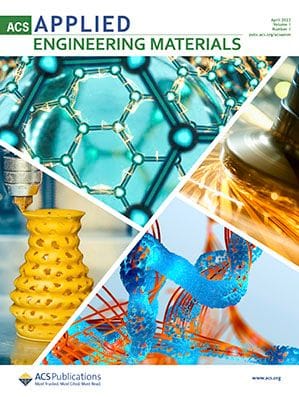This Virtual Special Issue seeks to highlight fundamental advances in additive manufacturing materials and techniques aimed at addressing global energy and climate challenges. Submit your manuscript by June 30, 2025.

In the last several years, interest in additive manufacturing (AM) has increased tremendously with recent innovations in printing technologies. These innovations have included the capability to print several functional materials with relevance to several energy and environmental applications such as catalysis, energy storage and conversion, separations, electronics, and composites.
These new AM materials and processes represent an opportunity to fabricate functional materials with complex geometries that can enable clean technologies that are vital to achieving global decarbonization and sustainability targets. However, there remain many challenges to reaching these energy and climate goals, including developing AM-compatible materials with properties on par with conventionally produced materials, determining the optimal design for AM devices, producing large builds with small features, and the scalability and cost of AM processes.
More progress in materials development, AM techniques, and theoretical approaches to simulating and optimizing AM materials and structures can help overcome many of these challenges and contribute to a paradigm shift in clean energy and environmental technologies.
ACS Applied Engineering Materials is seeking papers from an array of disciplines such as materials science, chemistry, physics, biology, and engineering, that leverage AM to address issues related to energy and the environment. Emphasis will be given to:
- Fundamental scientific and technological advances in AM materials and techniques;
- Case studies of structure-function studies, highlighting novel developments and concepts, including initiatives to overcome present limitations in catalysis, energy storage, electronics, and critical materials separations and recovery; and/or
- Advanced approaches to designing AM materials and structures, with focus on materials discovery, scalability, and optimization. Authors are encouraged to describe in their cover letters how submissions align with emphasis area(s).
We invite Articles, Mini-Reviews, Reviews, or Perspectives on all topics relating to additive manufacturing, including (but not limited to):
- Multi-material AM. Advances in techniques and materials synthesis that enable the printing of different materials (polymers, ceramics, metals, etc.) in a single AM build.
- Materials and Device Modeling of AM Devices. Concepts, Methodologies, and Applications. The combination of computational results with experimental techniques will be appreciated.
- Novel Device Concepts Enabled by AM. Device designs that cannot be realized without AM which provide significant advances over conventional device concepts. The combination of computational results with experimental techniques will be appreciated.
- Multifunctional Devices. Combining functions/processes that are conventionally done separately into a single device (e.g. structural batteries, separation/recovery, etc.)
Organizing Editors
Marcus Worsley, Associate Editor, Applied Engineering Materials
Lawrence Livermore National Laboratory, United States
Jeremy Feaster, Guest Editor
Lawrence Livermore National Laboratory, United States
Dong Lin, Guest Editor
Oregon State University, United States
Yat Li, Guest Editor
University of California, Santa Cruz, United States
Submission Information
The deadline for submissions is June 30, 2025.
Papers accepted for publication for this Special Issue will be available ASAP (as soon as publishable) online as soon as they are accepted. After all submissions have been published, they will then be compiled online on a dedicated landing page to form the Special Issue. All submissions will undergo a rigorous peer review process to ensure scientific soundness, novelty, and topical relevance.
How to Submit
- Log in to the ACS Paragon Plus submission site.
- Choose ACS Applied Engineering Materials as your journal.
- Select your manuscript type, and under the ‘Special Issue Selection,’ menu, choose ‘Additive Manufacturing for Energy and Environment.’
Please see our Author Guidelines for more information on submission requirements.
